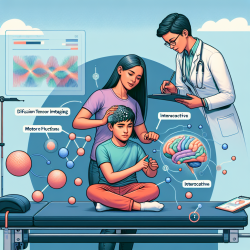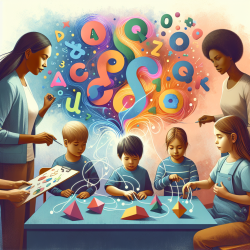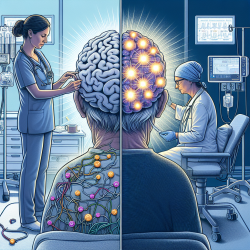Understanding Interoceptive Accuracy in Motor Functional Neurological Disorders
The recent study by Sojka et al. (2021) titled "Individual differences in interoceptive accuracy and prediction error in motor functional neurological disorders: A DTI study" provides intriguing insights into the complex relationship between brain structure and interoception in patients with motor functional neurological disorders (mFND). This research holds significant implications for practitioners, particularly those in the field of speech-language pathology, as it underscores the importance of interoceptive accuracy in therapeutic outcomes.
Key Findings from the Study
The study utilized diffusion tensor imaging (DTI) to investigate the integrity of white matter fiber bundles in 38 mFND patients compared to 38 healthy controls. Notably, the research found no significant differences in interoceptive accuracy or fractional anisotropy (FA) between the two groups. However, it highlighted distinct disruptions in right-lateralized tracts in the FND-seizure subgroup, particularly in the extreme capsule/inferior fronto-occipital fasciculus, arcuate fasciculus, inferior longitudinal fasciculus, and thalamic/striatum to occipital cortex projections. These disruptions were linked to the right temporoparietal junction and inferior temporal gyrus.
Implications for Practitioners
For practitioners, these findings emphasize the need to consider individual differences in interoceptive accuracy and prediction error when developing therapeutic interventions. Here are some practical steps practitioners can take:
- Integrate Interoceptive Training: Encourage activities that enhance interoceptive awareness, such as mindfulness and body awareness exercises, which may help improve the integrity of multimodal integration-related fiber bundles.
- Monitor Right-Lateralized Tract Integrity: Pay attention to symptoms that may indicate disruptions in right-lateralized tracts, particularly in children with FND-seizure characteristics, and adjust therapeutic approaches accordingly.
- Collaborate with Neurologists: Work closely with neurologists to better understand the neuroanatomical underpinnings of each child's condition, facilitating a more tailored and effective intervention plan.
Encouraging Further Research
While this study provides a foundational understanding of the relationship between interoception and brain structure in mFND, it also opens avenues for further research. Practitioners are encouraged to explore the following areas:
- Longitudinal Studies: Conduct longitudinal studies to assess how interoceptive training impacts brain structure and function over time in children with mFND.
- Cross-Disciplinary Research: Engage in cross-disciplinary research that combines insights from speech-language pathology, neurology, and psychology to develop comprehensive intervention strategies.
- Technology-Enhanced Interventions: Investigate the use of technology, such as virtual reality, to enhance interoceptive training and monitor changes in brain structure.
By integrating the findings from this study into practice, speech-language pathologists can enhance their therapeutic approaches, ultimately leading to better outcomes for children with motor functional neurological disorders.
To read the original research paper, please follow this link: Individual differences in interoceptive accuracy and prediction error in motor functional neurological disorders: A DTI study.










